The Eye of Horus Symbolism & Meaning
 What is the meaning behind the Eye of Horus?
What is the meaning behind the Eye of Horus?
The Eye of Horus is an ancient Egyptian symbol that represents protection, sacrifice, healing, regeneration, and royal power. It is also used to protect both the living and the dead from evil forces.
The story of the Eye of Horus
In ancient Egyptian myth, Osiris, the king of Egypt, was given all of the fertile land, while his brother, Set, received the barren deserts. Out of jealousy, Set murdered Osiris, claimed the throne, and brought chaos and disorder to Egypt.
Not only did Set kill Osiris, but because he wanted to keep him from entering the underworld, he cut his body up into 14 pieces and scattered them across the land. Ancient Egyptians believed that in order to enter the underworld, your body had to be intact, embalmed, and entombed.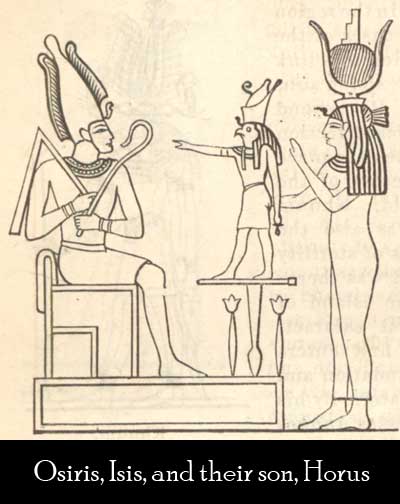
Osiris' wife, Isis, and his son, Horus, along with other family members, went on a quest to find all the pieces of his body. Isis then used her magic to resurrect him and he was then able to enter the underworld and become the god of the dead, of resurrection into eternal life, and the judge of the deceased.
Isis continued to raise Horus on her own and upon reaching adulthood, Horus went on a mission to avenge his father. In a series of fierce battles, Horus eventually defeated Set, but not without each of them sustaining heavy injuries. Set lost a testicle, and Horus lost one of his eyes.
In one version of the myth, Set tore out Horus' eye, cut it into six pieces, and threw it away. In another version, it was Horus himself who gouged out his own eye as a sacrifice in hopes of bringing his father back to life. It is from this version of the myth that the Eye of Horus has become a symbol of sacrifice.

In any case, Horus' eye was magically restored, either by Hathor, the goddess of the sky, women, fertility, and love, or by Thoth, the god of writing, magic, wisdom, and the moon. Because Horus' eye was restored by magic, ancient Egyptians believed it had healing properties.
How was the Eye of Horus used?
Ancient Egyptians didn't think of the eye as just a passive organ that we used for seeing the world; it was thought of as having special powers related to protection, taking actions, and anger. Eyes were thought to have powerful energy and could cast evil spells with just a glance. It was also believed that evil eyes could be counteracted with "good eyes", which led to beliefs around the protective power of the Eye of Horus.
In hieroglyphics, the Eye of Horus is represented by seven different symbols, with the meaning of "take action" or "one who does". Sailors harnessed its power by painting it on ships to protect them on dangerous voyages and to ward off evil forces. In this way, it is similar to the evil eye symbol.
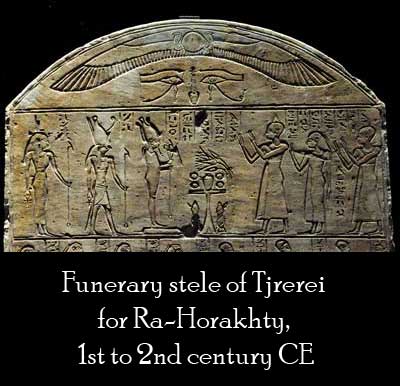 It was also used in funeral monuments and amulets to offer the dead safety and protection on their journey to the underworld and to ensure a good and safe afterlife.
It was also used in funeral monuments and amulets to offer the dead safety and protection on their journey to the underworld and to ensure a good and safe afterlife.
How is it used today?
Today, the Eye of Horus is still used for protection against evil forces and is also believed to bring good health, rejuvenation, energy, and vitality to its wearer.
It is placed in homes to improve safety and security from both physical and emotional dangers. It is also used in magic spells, to keep negative energy away and to attract positive energy.
Relationship of the Eye of Horus to the human brain
Another name for the Eye of Horus is the "Eye of the Mind". Incredibly, when the Eye of Horus is superimposed over a cross-section of the human brain, each of the six sections of the Eye seem to correspond to the major sensory centers of our five senses and to the corpus callosum, the largest collection of white matter fibers in the brain that facilitates communication between the two halves of the brain.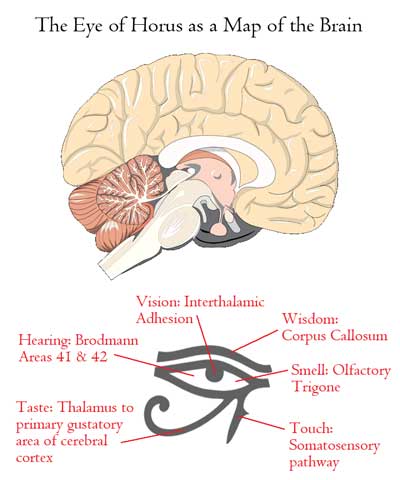
What is amazing about this correspondence is that the ancient Egyptians, who were leaders in medicine and anatomy, seemed to understand the intricate functions of the central nervous system without the benefits of modern technology. The following is a list of each part of the Eye of Horus to sections of the brain:
Smell: The triangular-shaped section on right side of eye is located in the olfactory trigone.
Vision: The center of eye corresponds to the interthalamic adhesion.
Wisdom: The eyebrow corresponds to the shape and location of the corpus callosum.
Hearing: The triangular left side of the eye corresponds to the location of the Brodman areas 41 and 42, which are the center of hearing in humans.
Taste: The coiled, tail-shaped object corresponds to the taste pathway in the brain.
Touch: The teardrop-shaped object corresponds to the shape and location of the somatosensory pathway, the carrier of many sensations from the body.
The Eye of Horus and mathematics
There is yet another fascinating element of symbolism in the Eye of Horus as it relates to mathematics. The Eye can be divided into six individual elements (the six pieces of the eye that were ripped apart by Set, and that also correspond to the different parts of the brain), each of which is assigned a fraction, as follows:
½ corresponds to the outer triangle of the eye
¼ corresponds to the pupil
1/8 corresponds to the eyebrow
1/16 corresponds to the inner triangle of the eye
1/32 corresponds to the the curled "tail"
1/64 corresponds to the teardrop shape
If you then add up the fractions, they do not equal 100%, as expected, but instead only add up to 63/64, or 98.43%. It is said that the missing fraction was either withheld by Thoth's magic when he restored the eye, or that the magic itself is the missing piece. Another interpretation is to say that nothing is perfect.
The Eye of Horus as a symbol of the moon
Ancients believed that Horus' right eye represented the sun, and his left eye, the moon, meaning that he ruled all of the heavens. Because it is believed that it was Horus' left eye which was gouged out, the Eye of Horus also represents the waxing and waning moon. The nights when there is no moon in the sky represents the time when Horus' eye was ripped out, and the full moon represents the eye that has been restored by magic.
The Eye of Horus and divine royalty
Horus' name means "the falcon who soars above all the other inhabitants of the land". Horus is the god of the sky and is often shown with the head of a falcon or as a falcon itself. The Eye of Horus is shaped to resemble a falcon's eye, along with the distinctive teardrop on the bottom. 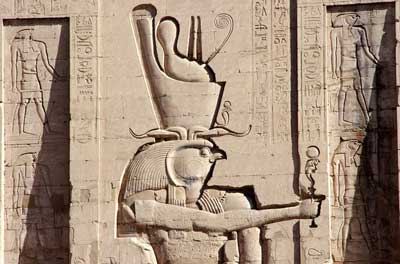
The Eye of Horus has also been seen in royal courts and royal garments. This is because ancient Egyptians believed that pharoahs were the living embodiment of Horus and that when one pharoah died, his spirit was passed down to the next one.
The Eye of Horus and the Pineal Gland
The pineal gland is a tiny, pinecone-shaped gland located near the center of the brain, at the same level as the eyes. The famous philosopher Descartes called it the "principal seat of the soul". It is also known as the "third eye" and is thought to be a bridge between the physical and spiritual worlds.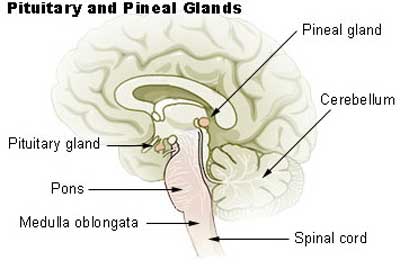
Many cultures throughout the world have some belief in the idea of the third eye. In ancient Indian texts, the chakra located between the eyebrows is believed to be the connection to divine consciousness. In China, "third eye training" involves closing the eyes and focusing one's attention on the spot between the eyebrows, while posed in various qigong positions. This focus allows the student to tune into the correct "vibration" in the universe so that they can achieve an advanced meditative state. In Egypt, the third eye was the Eye of Horus.
The pineal gland is also thought to be a doorway to lucid dreaming, mental telepathy, extra-sensory perception, and spiritual visions.
The Eye of Horus vs. the Eye of Ra
Originally, both the right and left eyes were associated with Horus, but over time, the right eye became associated with Ra, the god of the sun, order, kings, and the sky. The story of the Eye of Ra begins when Ra was the actual pharoah of Egypt. Feeling that his people had lost respect for him, he sent his eye, in the form of a lion, to punish humanity.
The Eye of Ra rampaged through the land, destroying everything in its path. It killed so many people that the gods feared it would kill all of humanity. To calm down the Eye, Ra poured beer stained with pomegranate juice over the land to fool the Eye into thinking it was human blood.
After drinking all the beer, the Eye of Ra calmed down, passed out, and later returned to Ra, restoring peace to humanity.
The Eye of Ra has been associated with the use of violence to control one's enemies and with the destructive power of the sun. It is also a symbol of authority, with its power used for protection of the pharoah, holy places, and ordinary people.
Both the Eye of Horus and the Eye of Ra are believed to be protective, but it is their origin stories that define the nature of their powers. The Eye of Horus offers safety and protection for the living and the dead on dangerous journeys and wards off malevolent forces, while the Eye of Ra's protective powers originate in the use of violence to subdue one's enemies. The main difference seems to be that the Eye of Horus offers protection in a peaceful, defensive way, deflecting evil forces, while the Eye of Ra offers protection by inciting in enemies the fear of destruction.

Furthermore, the Eye of Horus is a symbol of the moon and the Eye of Ra is a symbol of the sun. Even so, in today's world, you'll find that the right and left eyes are often used interchangeably as the Eye of Horus, as it is the more popular symbol.
Fun Fact about the Eye of Horus
The supermodel Naomi Campbell owns a large house in the shape of the Eye of Horus on a small island near Turkey called Cleopatra's Island. She received it as a gift for her 41st birthday from her Russian billionaire boyfriend Vladislav Doronin. It was designed to be completely energy, water and food self-sufficient and has 25 bedrooms and 5 lounges.
Conclusion
I hope you enjoyed this short exploration into the meaning behind the Eye of Horus and that when you now wear this powerful symbol, you understand a little more about its ancient origins and why it is thought to have positive, protective powers.
This article is brought to you by Woot & Hammy - "Our mission is to be a place for Wiccans, Pagans, and others to find affordable, high-quality jewelry that will help them express themselves and their beliefs, and by doing so, help to expand awareness and acceptance of them and their communities." Click here to visit our site.
References:
Dhwty, "Eye of Horus: The True Meaning of an Ancient, Powerful Symbol", November 18, 2018, https://www.ancient-origins.net/artifacts-other-artifacts/eye-horus-0011014
Karim ReFaey, "The Eye of Horus: The Connection Between Art, Medicine, and Mythology in Ancient Egypt", May 23, 2019, https://www.cureus.com/articles/19443-the-eye-of-horus-the-connection-between-art-medicine-and-mythology-in-ancient-egypt
David Rymer BA MBT, "Eye of Horus – Complete Guide on the Meaning Behind the Symbol," Give Me History, January 20, 2020, https://givemehistory.com/the-eye-of-horus
"Eye of Horus", https://en.wikipedia.org/wiki/Eye_of_Horus
"Horus, the Egyptian Falcon God", https://www.ask-aladdin.com/egypt-gods/horus/#:~:text=Horus%20%2D%20The%20Egyptian%20Falcon%20God&text=EgyptAir%20has%20even%20used%20the,king%20who%20ruled%20over%20Egypt
Akhand Gyand, "Pineal Gland - The Epicenter of Enlightenment", https://www.magzter.com/article/Culture/Akhand-Gyan-English/Pineal-Gland-The-Epicentre-Of-Enlightenment
Colleen Kane, "Naomi Campbell's Horus-Eye Eco House", https://www.cnbc.com/2011/09/27/Naomi-Campbells-Horus-Eye-Eco-House.html
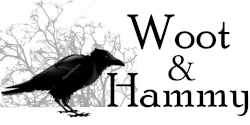

 What is the meaning behind the Eye of Horus?
What is the meaning behind the Eye of Horus?

187 Comments
The article is well researched and reveals hidden things.Tell us more.
loNeVYzjGRi
vCKnHXqcjahg
VFgIGhLYp